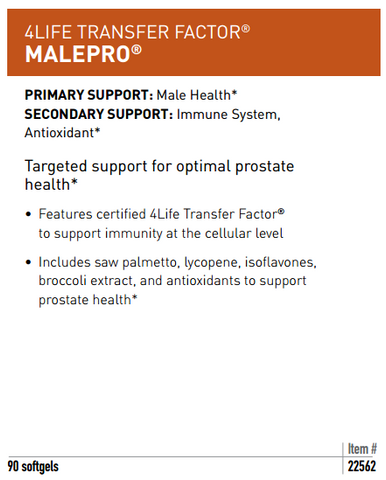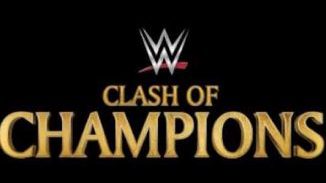malepro reviews
We often think in terms of what we take into our bodies, most of which are unhealthy drugs to change function and can do damage. This product is all-natural and has no side effects that can cause damage to your health. This product is designed to support prostate health and urinary function. This system is essential that it be working right, as all systems need to be for good health and proper function. Individual needs for this product will depend on what it is the body may require for support. You must understand that ONLY THE BODY HEALS and is responsible for normal function. This is a universal law but one that is often ignored in the marketed world of healthcare in which people are always looking outside the body for cures or to chemically alter function for immediate gratification and not necessarily better health. This product is focused on supporting the endocrine system of men as well as antioxidant support as a man ages. 4Life Transfer Factor MalePro has been created specifically in support of the function and maintaining a healthy performance from a natural perspective.
WHY SHOULD YOU TAKE THIS PRODUCT?
One of the most sensitive areas for men to discuss is their performance, as a man. Still, an area filled with rumors, pride, and deception, there comes a point when the results matter and there is no getting around whether or not there is satisfaction in the body’s ability to perform. One of the most sold drugs is made available for the ability to artificially enhance the performance of the male, even though there are dangers in its use, and questionable results, these drugs have become the largest selling “recreational” drugs on the legal marketplace. Yet, there are safer and healthier ways in which this body function can be supported. That is why Nutrition is the essential aspect of good health and physical performance. This leads us, or at least those who feel that nutrition is essential in having better health to add many supplemental elements to their diets. Supplements have now become a major nutritional part of most people’s everyday life. The reason for taking supplements varies according to one’s age, environment, natural resistance, stress, lifestyle, and all other factors that one has in their life. For that reason, there is no “one fits all” product that meets the needs of all individuals, especially when it comes to the performance of a man. But for those who are more interested in better health as well in how their body can better perform then this is an important subject. A product for the subject of discussion regarding this subject is 4Life Transfer Factor MalePro.

WHAT CAN THIS PRODUCT DO FOR YOU?
We often think in terms of what we take into our bodies, most of which are unhealthy drugs to change function and can do damage. This product is all-natural and has no side effects that can cause damage to your health. This product is designed to support prostate health and urinary function. This system is essential that it be working right, as all systems need to be for good health and proper function. Individual needs for this product will depend on what it is the body may require for support. You must understand that ONLY THE BODY HEALS and is responsible for normal function. This is a universal law but one that is often ignored in the marketed world of healthcare in which people are always looking outside the body for cures or to chemically alter function for immediate gratification and not necessarily better health. This product is focused on supporting the endocrine system of men as well as antioxidant support as a man ages. 4Life Transfer Factor MalePro has been created specifically in support of the function and maintaining a healthy performance from a natural perspective.
HOW DOES YOUR BODY BENEFIT FROM THIS PRODUCT?
TRANSFER FACTOR MALEPRO offers support through multiple ingredients. As a “targeted” transfer factor product, MALEPRO has been formulated with those compounds and elements that best support prostate health. With ingredients to support urinary function as well as having those ingredients to support the body’s immune system. The desire of every consumer should be for the primary concern of the need to prevent the breakdown of the body. But in cases in which the body has begun to show signs of distress or failure to function that may or may not have been diagnosed. In such cases, it is essential that the benefits of additional nutritional support should be considered.
WHAT ARE THE POSSIBLE RESULTS OF TAKING THIS PRODUCT?
Remember that only the body heals and each body’s needs are different according to all the factors of daily life. 4Life Transfer Factor MalePro is a supplement that has allowed a lot of people to testify to the improvement in their area of performance and even in medical testing as to any chemical imbalance which might affect the system. This product is there to assist the body in maintaining better health, but in many cases, it has been part of the support for their body in overcoming performance concerns. This is a product that can also be used with other natural supplements in the individual body’s specific support criteria.
Stages, winner scores: 30
The all-time list of British male pro road riders
Last update September 10, 2019.
1. Chris Froome 6,310 points [Pro: 2007-present]
2. Mark Cavendish 4,010 points [Pro: 2007-present]
3. Robert Millar 2,900 points [Pro: 1980-1995]
4. Bradley Wiggins 2,710 points [Pro: 2002-2016]
5. Tom Simpson 2,545 points [Pro: 1958-1967]
6. Geraint Thomas 2,005 points [Pro: 2006-present]
7. Chris Boardman 1,965 points [Pro: 1993-2000]
8. David Millar 1,580 points * [Pro: 1997-2014]
9. Barry Hoban 1,455 points [Pro: 1962-1981]
10. Simon Yates 1,210 points [Pro: 2014-present]
11. Michael Wright 800 points [Pro: 1962-1976]
12. Adam Yates 775 points [Pro: 2014-present]
13. Max Sciandri 675 points ** [Pro: raced as a British rider 1995-2004]
14. Sean Yates 635 points [Pro: 1982-1996]
15. Brian Robinson 605 points [Pro: 1952-1963]
16. Ben Swift 470 points [Pro: 2007-present]
17. Steve Cummings 425 points [Pro: 2005-present]
18. Malcolm Elliott 380 points [Pro: 1984-1997]
19. Ian Stannard 370 points [Pro: 2007-present]
20. Alex Dowsett 270 points [Pro: 2011-present]
21. Roger Hammond 235 points [Pro: 1998-2011]
22. Jeremy Hunt 230 points [Pro: 1996-2012]
23. Luke Rowe 180 points [Pro: 2012-present]
24. Vin Denson 155 points [Pro: 1959-1969]
25. Alan Ramsbottom 150 points [Pro: 1961-1966]
* David Millar: Points for results that were stripped after admitting he had doped are not included (for example world time trial championship 2003).
** Max Sciandri: Only points scored from 1995 onwards, when Sciandri took out a British racing licence, are included.
Scroll down to see how the points have been allocated
Analysing CW’s ranking
Chris Froome is the British number one after winning the 2013, 2015 and 2016, 2017 editions of the Tour de France, plus a victory in the 2017 Vuelta a España, a victory in the Giro d’Italia in 2018, and second places in the 2011, 2014 and 2016 editions of the Vuelta, second place in 2012 Tour and third place in the 2018 Tour.
From humble beginnings, Froome established himself as one of the world’s foremost stage racers, with victories in the Critérium du Dauphiné, Tour de Romandie, Critérium International, Tour of Oman and Vuelta a Andalucia to add to his Grand Tour success.
When Mark Cavendish won the sixth stage of the 2013 Giro d’Italia he moved ahead of Robert Millar in our ranking. Though – as a pure sprinter – he will never win a Grand Tour it is the sheer number of his wins that impresses, including 30 stage wins in the Tour alone.
Cavendish has also rewritten the British cycling history books. He is the first British rider to win four stages in a single Tour de France (2008) and has since won six in one edition of the Tour (2009), taken the Tour’s green jersey (2011) and road race World Championship title (2011).
Scotland’s Robert Millar is third in the ranking. In 16 years as a professional (1980-1995), Millar was one of the finest climbers in the peloton.
Millar finished on the podium at the Giro d’Italia (second in 1987) and the Vuelta a España (second in 1985 and 1986). Millar’s fourth place in the 1984 Tour de France was the highest by a British rider at that point. That year he also won the polka-dot jersey as king of the mountains.
That Millar is one of Britain’s greatest ever stage racers is in little doubt. But it wasn’t just in the Grand Tours that Millar excelled. He also won the Dauphiné Libéré (1990) and Volta a Catalunya (1985). His best one-day performances were sixth in the World Championships road race in Barcelona in 1984, and third in the 1988 Liège-Bastogne-Liège.
Bradley Wiggins‘ transformation from Olympic gold-medal winning track rider to Grand Tour contender first came to the fore in the 2009 Tour de France, where he equalled Robert Millar’s record in fourth overall. Wiggins’ result was later upgraded to third after Lance Armstrong’s results were wiped from the record books for doping. Crashing out of the 2011 Tour, Wiggins subsequently recovered to take third in the Vuelta behind Chris Froome in second.
Then in 2012 it all came right for Wiggins, winning Paris-Nice, Critérium du Dauphiné and Tour de Romandie on his way to becoming the first British rider to win the Tour de France overall. Olympic gold followed in the time trial.
What our ranking doesn’t take into account is Wiggins’ success on the track. With seven Olympic track medals, four of them gold, it’s hard to argue against Wiggins being Britain’s greatest all-round cyclist.
Tom Simpson also deserves to be recognised as one of the greatest Britons, and while the Millar’s Grand Tour performances give him the edge in our ranking, there is no doubt Simpson’s palmarès is stronger.
In the 1960s he won the world professional road race title and three of the one-day races universally recognised as the Monuments of cycling – Milan-San Remo, the Tour of Flanders and Il Lombardia. Add to that a sixth-place finish in the Tour de France and a string of other top-10 finishes in the Classics.
Geraint Thomas became Britain’s third ever Grand Tour winner with his victory in the 2018 Tour de France, where he also took two stage wins.
Like Wiggins, Thomas transformed himself from double Olympic gold medallist on the track, to Classics contender, to stage racer and eventually a Tour de France winner. Thomas has taken stage victories in Paris-Nice and the Critérium du Dauphiné as well as winning cobbled Classic E3 Harelbeke and top-10 finishes in Paris-Roubaix and the Tour of Flanders.
Many fans still consider Chris Boardman to have been a time trial specialist with very few other strings to his bow, but a closer examination of his career shows that to be an unfair assessment.
Yes, the great majority of Boardman’s 41 wins were achieved in time trial stages, and he never made an impression on the general classification of the Tour de France or the one-day Classics. But he did finish second and fifth overall in the Dauphiné Libéré and third in Paris-Nice, results which are sometimes overlooked.
David Millar‘s first Tour de France stage win came in 2000, and his last in 2012. He has led all three Grand Tours, and won stages in each.
In ninth place is Barry Hoban, who clocked up a lot of points by winning eight stages of the Tour de France and Ghent-Wevelgem but was also third in the Tour’s green jersey competition one year, as well as third in Paris-Roubaix and Liège-Bastogne-Liège.
Simon Yates is the biggest recent mover in the list thanks to his strong showing at the 2018 Giro d’Italia, victory overall at the 2018 Vuelta a España. Yates wore the maglia rosa of the Giro race leader for 13 days, taking three stage wins while wearing it. He ceded to another rider on this list, number one Chris Froome, after fading on the penultimate mountain stage of the race. Yates also wore the red leader’s jersey of the Vuelta for a total of 11 days and won a single stage en route to his first overall Grand Tour victory.
Simon’s twin brother Adam Yates also occupies a spot in the list in 12th, thanks to his fourth overall at the 2016 Tour de France and stage victories in the Critérium du Dauphiné and Tirreno-Adriatico.
Michael Wright, who was British born but lived most of his life in Belgium, is usually considered a sprinter and Classics rider, but he was also fifth overall in the 1969 Vuelta a España.
In 12th place is Max Sciandri who switched nationality from Italian to British in the mid-1990s and had a good record in one-day races.
Some may be surprised to see Sean Yates, who was considered to be a domestique, so high, but he had a long career spanning 15 seasons and won some big races. Among his victories were stages of the Tour de France, Vuelta a España and Paris-Nice, as well as the Tour of Belgium’s overall title. He was also second at Ghent-Wevelgem, behind Gerrit Solleveld in 1988, and fifth in Paris-Roubaix.
Brian Robinson can be seen as one of the pioneers of British cycling. He went to France and made an impact in the 1950s, paving the way for the Simpson generation to try to make a living in the sport. Robinson was a respected team worker, but he won too, most notably the Dauphiné Libéré in 1961 and a stage in the Tour de France. He was also third in the 1957 Milan-San Remo, at the time a truly jaw-dropping achievement.
Late in Gravity’s Rainbow, the narrator describes a culvert in the middle of a narrow road. There is a variety of graffiti in it from those who have taken shelter there, including a drawing of a man looking closely at a flower.
Postmodern Culture
The title of Tania Modleski’s Feminism Without Women refers, Modleski explains, to a confluence of two political/intellectual trends: the subsumption of feminism within a “more comprehensive” field of gender studies, accompanied by the rise of a “male feminist perspective that excludes women,” and the dominance within feminist thought of an “anti-essentialism so radical that every use of the term ‘woman,’ however ‘provisionally’ it is adopted, is disallowed” (14–15). The two trends are linked, Modleski argues, because “the rise of gender studies is linked to, and often depends for its justification on, the tendendency within poststructuralist thought to dispute notions of identity and the subject” (15). These trends are troubling for Modleski because she fears that, insofar as gender studies tend to decenter women as the subjects of feminism, they may be not a “new phase” in feminism but rather feminism’s “phase-out” (5).
My concern in this essay is with male-authored work on gender of the type identified by Modleski, and in particular with its intersections with anti-essentialism (which, for the purposes of this essay, I will define broadly as the belief that gender is socially constructed). Although not all male-authored gender criticism by men is radically anti-essentialist 1 , I believe that the confluence between anti-essentialism and male-authored work on gender exceeds mere theoretical justification. Anti-essentialism is both symptom and cause of a deep anxiety which I take to underlie much gender criticism written by men today, an anxiety about being a male subject in a society in which male subjectivity has been identified as a problem. On the one hand, an awareness of the social construction of the self can lead to a heightened anxiety in men about gender, as it implies an awareness of the complicity of male subjectivity with social structures which are oppressive to women. On the other hand, male anxiety about gender can encourage an anti-essentialist viewpoint, both because anti-essentialism appears to offers hope that positive changes in gender identity are possible and because anti-essentialism can diffuse personal responsibility by shifting the object of critique from the self to social codes which have “always already” constructed the self.
In speaking in this way about “men,” “male subjectivity,” and the like, I am not at all presupposing that all men in contemporary culture are alike. I do think that the anxiety I am identifying is widespread, but it is not universal, and even for those men who feel such anxiety there are many ways to respond, including the direct backlash against feminism identified by Susan Faludi and others. My interest in this essay lies with a fairly narrow spectrum of men: those men who accept to some degree the charge that male subjectivity is a political problem of some kind — male anti-masculinists, for lack of a better term, since not all can be considered pro-feminist. 2 I wish to explore the relationship between anti-masculinism and anti-essentialism in male authors and to determine whether anti-essentialism is a viable political strategy for male anti-masculinists. To this end I shall examine a text by a male writer, Gravity’s Rainbow by Thomas Pynchon, in which the relationship between an anxiety about gender and a anti-essentialist view of the self is particularly complex and revealing. 3 I shall argue that, just as Modleski suggests, anti-essentialism in the novel does indeed serve to decenter women’s perspectives, and that, while anti-essentialism has been and still is an important part of pro-feminist men’s understanding of their gender identities, it is not a sufficient base for a politics which is not merely anti-masculinist but pro-feminist.
Late in Gravity’s Rainbow, the narrator describes a culvert in the middle of a narrow road. There is a variety of graffiti in it from those who have taken shelter there, including a drawing of a man looking closely at a flower.
In the distance, or smaller, appears to be a woman, approaching. Or some kind of elf, or something. The man isn’t looking at.
TSS: Training Stress Score is a measure of the intensity and duration of a ride. A TSS of 100 represents a 100%, hour-long effort, but since most rides aren’t completed at 100% intensity, most efforts will accumulate less than 100 TSS per hour. Click here to learn more about TSS.
Following an attack on a short climb
If you saw the 2017 Milan-San Remo you almost certainly remember the blistering attack from Peter Sagan (Bora-Hansgrohe) on the Poggio. Only two riders could follow him and one of them, Michal Kwiatkowski (Team Sky), went on to win the race.
For Kwiatkowski to follow Sagan on the climb he had to do the following:
Distance: 3.5km
Time: 5:57
Average Power: 443W
Power-to-weight: 6.51 W/kg
The numbers are highly impressive even before you consider this was after seven hours of racing — almost 300km deep. Perhaps the biggest indicator that the professionals are a step above even the best amateurs is the fact “Kwiato” needed to average 619W for the last 800m of the climb at an incredible 9.1 W/kg. The best A-grade riders would struggle to do this fresh, and certainly couldn’t seven hours into a race.
To top it off, Kwiatkowski averaged 1,149W (16.9W/kg) for the last five seconds of the race to just get past Sagan. Most amateurs are happy to see over 1,000 watts in a max sprint, and again this is without nearly 300km in their legs.
Dot Net readers were allowed a single vote per day for each of the 2021 awards categories. The following are the results of our poll for Best Male Pro Wrestler. Thanks to everyone who took part in the voting. We will unveil the rest of the awards today. The previously announced awards are available in our 2021 Awards section.
Dot Net Awards: 2021 Best Male Pro Wrestler
Dot Net readers were allowed a single vote per day for each of the 2021 awards categories. The following are the results of our poll for Best Male Pro Wrestler. Thanks to everyone who took part in the voting. We will unveil the rest of the awards today. The previously announced awards are available in our 2021 Awards section.
1. Bryan Danielson (33 percent)
2. Roman Reigns (22 percent)
3. Kenny Omega (11 percent)
4. Adam Page (6 percent)
5. Josh Alexander (5 percent each)
Others (23 percent)
Jason Powell’s Thoughts: The right man won the award. I’m all for Roman Reigns as the MVP (the results of that award will be available later today), but I would not give him my vote for the Best Wrestler award. At this point, I don’t know if it’s even possible for Bryan Danielson to have a bad match. He’s had so many gems with a wide variety of opponents, and I feel like the best is yet to come with fresh opponents in AEW and perhaps even New Japan Pro Wrestling. Kenny Omega had a good year, but he was injured and he’s certainly had better campaigns. It speaks volumes about his talent and drive that he was still able to finish third despite working through some serious injuries. Adam Page was a very consistent performer and had his share of great matches. It’s nice to see Josh Alexander crack the top five in recognition of his strong year in Impact Wrestling.
Related Posts

Lutz’s Blog: There’s no reason for Cody to worry about perception of his AEW wrestler/executive status

Powell’s MLW Fusion TV Review: Episode Five with Pentagon Jr. vs. Rey Fenix in a double jeopardy match to become No. 1 contender to the MLW Championship, The Dirty Blondes vs. Jimmy Yuta and Jason Cade in an elimination match, Trey Miguel vs. Kotto Brazil

Powell’s WWE Clash of Champions Hit List: Roman Reigns vs. Jey Uso for the WWE Universal Championship, Drew McIntyre vs. Randy Orton in an Ambulance Match for the WWE Championship, Jeff Hardy vs. AJ Styles vs. Sami Zayn in a ladder match for the Intercontinental Title
Readers Comments (2)
The best wrestler is the one that draws the most money. That’s Reigns by a mile these days.
Anybody can do moves and it doesn’t affect the bottom line at all (hence AEW ratings not budging for the arrival of guys like Danielson and Punk).
Yeah, and the best boxer in the world is Logan Paul.
School was never my strong suit, I struggled academically. During my brief time as a high-rise window cleaner, I discovered that I enjoyed physical work – completing a task made me feel accomplished. I also enjoyed being able to move around for work and meet new people. Essentially, each new job felt like a new adventure.
Members Perspective

I joined the union five years ago as a Glazier and it has lead to many great opportunities. From a pension for my future to medical benefits for myself and my family, IUPAT and my brother and sisters have always been there when needed. For anyone who isn’t sure what to do with their life, I always recommend looking into the union.

School was never my strong suit, I struggled academically. During my brief time as a high-rise window cleaner, I discovered that I enjoyed physical work – completing a task made me feel accomplished. I also enjoyed being able to move around for work and meet new people. Essentially, each new job felt like a new adventure.
When I began working with the union, I really felt I had found the right fit for me. The union gave me an opportunity to further myself and challenge myself in ways that made me feel capable and gave me security. Rather than digging myself into a hole of never-ending student debt, discovering my passion and abilities in industrial and commercial painting allowed me to make income while becoming certified during my apprenticeship.